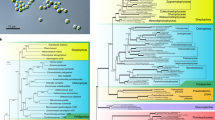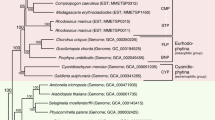Abstract
It has long been suspected that chloroplasts evolved after an endosymbiotic event involving a photosynthetic prokaryote, presumably a cyanobacterium, and a eukaryotic organism. Recent studies have provided strong evidence about the cyanobacterial nature of chloroplasts1. Since the discovery of prochlorophytes2, oxygen-evolving photosynthetic prokaryotes containing chlorophyll a and chlorophyll b and lacking phycobiliproteins, there has been speculation that these represent evolutionary intermediates between cyanobacteria and chloroplasts3. Prochloron sp., the first described prochlorophyte, proved difficult to work with because it is an obligate symbiont of marine ascidians3.Prochlorothrix hollandica, a recently isolated, freshwater filamentous prochlorophyte, is easily maintained in the laboratory3,4. Overall pigment composition and thylakoid membrane structure of P. hollandica suggest it has intermediate characteristics between cyanobacteria and the chloroplasts of higher plants3. The P. hollandica psbA genes, which encode the photosystem II thylakoid protein Dl, were cloned and sequenced and the sequences compared to those reported for cyanobacteria, a green alga, a liverwort, and several higher plants. The two psbA genes present in P. hollandica encode an identical amino-acid sequence. As in all chloroplast psbA genes, there is a seven amino-acid gap near the C terminus of the derived protein relative to the protein predicted by cyanobacterial genes5, suggesting that P. hollandica is part of the lineage that led to chloroplasts after a divergence from cyanobacteria. This hypothesis is also supported by phylogenetic analysis of derived Dl amino-acid sequences from psbA genes of thirteen taxa on the basis of parsimony.
This is a preview of subscription content, access via your institution
Access options
Subscribe to this journal
Receive 51 print issues and online access
$199.00 per year
only $3.90 per issue
Buy this article
- Purchase on Springer Link
- Instant access to full article PDF
Prices may be subject to local taxes which are calculated during checkout
Similar content being viewed by others
References
Giovannoni, S. J. et al. J. Bact. 170, 3584–3592 (1988).
Lewin, R. A. Nature 261, 697–698 (1967).
Burger-Wiersma, T., Veenhuis, M., Korthals, H. J., Van de Wiel, C. C. M. & Mur, L. R. Nature 320, 262–264 (1986).
Bullerjahn, G. S., Matthijs, H. C. P., Mur, L. R. & Sherman, L. A. Eur. J. Biochem. 168, 295–300 (1987).
Curtis, S. & Haselkorn, R. Pl. molec. Biol. 3, 249–258 (1984).
Golden, S. S., Bruslan, J. & Haselkorn, R. EMBO J. 5, 2789–2798 (1986).
Palmer, J. A. Rev. Genet. 19, 325–354 (1985).
Meyer, T. E., Cusanovich, M. A. & Kamen, M. D. Proc. natn. Acad. Sci. U.S.A. 83, 217–220 (1986).
Maxwell, E. J., Liu, J. & Shively, J. M. J. molec. Evol. 23, 300–304 (1986).
Swofford, D. L. PAUP User's Manual Version 2.4. (Illinois Natural History Survey, Champaign, Illinois, 1985).
Ochman, H. & Wilson, A. C. J. molec. Evol. 26, 74–86 (1987).
Wilson, A. C., Ochman, H. & Prager, E. M. Trends Genet. 3, 241–247 (1987).
Chisholm, S. W. et al. Nature 334, 340–343 (1988).
Maniatis, T., Fritsch, E. F. & Sambrook, J. Molecular Cloning: a Laboratory Manual (Cold Spring Harbor Laboratory, New York, 1982).
Mulligan, B., Schultes, N., Chin, L. & Bogorad, L. Proc. natn. Acad. Sci. U.S.A. 81, 2693–2697 (1984).
Osiewacz, H. D. & McIntosh, L. Nucleic Acid Res. 15, 10585 (1987).
Erickson, J. M., Rahire, M. & Rochaix, J.-D. EMBO J. 3, 2753–2762 (1984).
Ohyama, K. et al. Nature 322, 572–574 (1986).
Zurawski, G., Bohnert, H. J., Whitfield, P. R. & Bottomley, W. Proc. natn. Acad. Sci. U.S.A. 79, 7699–7703 (1982).
Spielmann, A. & Stutz, E. Nucleic Acid Res. 11, 7157–7167 (1983).
Aldrich, J., Cherney, B. & Merlin, E. Nucleic Acid Res. 14, 9537 (1986).
Hirschberg, J. & McIntosh, L. Science 22, 1346–1349 (1983).
Shinozaki, K. et al. EMBO J. 5, 2043–2049 (1986).
Aldrich, J., Cherney, B., Merlin, E., Christopherson, L. A. & Williams, C. Nucleic Acid Res. 14, 9536 (1986).
Goloubinoff, P., Edelman, M. & Hallick, R. B. Nucleic Acid Res. 12, 9489–9496 (1984).
Author information
Authors and Affiliations
Rights and permissions
About this article
Cite this article
Morden, C., Golden, S. psbA genes indicate common ancestry of prochlorophytes and chloroplasts. Nature 337, 382–385 (1989). https://doi.org/10.1038/337382a0
Received:
Accepted:
Issue Date:
DOI: https://doi.org/10.1038/337382a0
This article is cited by
-
Species concepts and speciation factors in cyanobacteria, with connection to the problems of diversity and classification
Biodiversity and Conservation (2015)
-
Mechanism of isoproturon resistance in Phalaris minor: in silico design, synthesis and testing of some novel herbicides for regaining sensitivity
Journal of Molecular Modeling (2012)
-
Conserved structure of the chloroplast-DNA encoded D1 protein is essential for effective photoprotection via non-photochemical thermal dissipation in higher plants
Molecular Genetics and Genomics (2010)
-
A Ser–Gly substitution in plastid-encoded photosystem II D1 protein is responsible for atrazine resistance in foxtail millet (Setaria italica)
Plant Growth Regulation (2007)
Comments
By submitting a comment you agree to abide by our Terms and Community Guidelines. If you find something abusive or that does not comply with our terms or guidelines please flag it as inappropriate.



